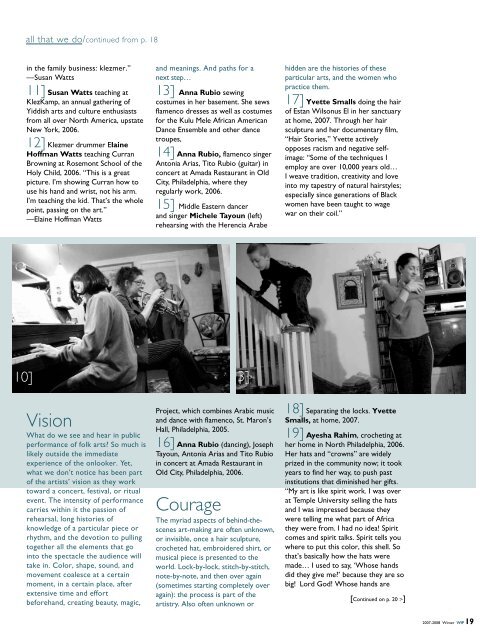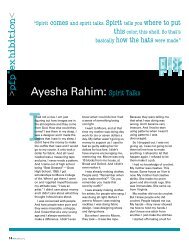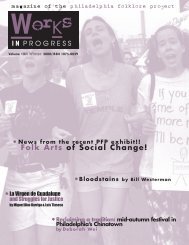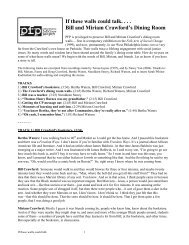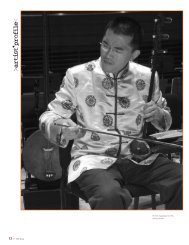African song / Fatu Gayflor ⢠War and wealth - Philadelphia Folklore ...
African song / Fatu Gayflor ⢠War and wealth - Philadelphia Folklore ...
African song / Fatu Gayflor ⢠War and wealth - Philadelphia Folklore ...
Create successful ePaper yourself
Turn your PDF publications into a flip-book with our unique Google optimized e-Paper software.
all that we do/continued from p. 18<br />
in the family business: klezmer.”<br />
—Susan Watts<br />
11] Susan Watts teaching at<br />
KlezKamp, an annual gathering of<br />
Yiddish arts <strong>and</strong> culture enthusiasts<br />
from all over North America, upstate<br />
New York, 2006.<br />
12] Klezmer drummer Elaine<br />
Hoffman Watts teaching Curran<br />
Browning at Rosemont School of the<br />
Holy Child, 2006. “This is a great<br />
picture. I’m showing Curran how to<br />
use his h<strong>and</strong> <strong>and</strong> wrist, not his arm.<br />
I’m teaching the kid. That’s the whole<br />
point, passing on the art.”<br />
—Elaine Hoffman Watts<br />
<strong>and</strong> meanings. And paths for a<br />
next step…<br />
13] Anna Rubio sewing<br />
costumes in her basement. She sews<br />
flamenco dresses as well as costumes<br />
for the Kulu Mele <strong>African</strong> American<br />
Dance Ensemble <strong>and</strong> other dance<br />
troupes,<br />
14] Anna Rubio, flamenco singer<br />
Antonia Arias, Tito Rubio (guitar) in<br />
concert at Amada Restaurant in Old<br />
City, <strong>Philadelphia</strong>, where they<br />
regularly work, 2006.<br />
15] Middle Eastern dancer<br />
<strong>and</strong> singer Michele Tayoun (left)<br />
rehearsing with the Herencia Arabe<br />
hidden are the histories of these<br />
particular arts, <strong>and</strong> the women who<br />
practice them.<br />
17] Yvette Smalls doing the hair<br />
of Estan Wilsonus El in her sanctuary<br />
at home, 2007. Through her hair<br />
sculpture <strong>and</strong> her documentary film,<br />
“Hair Stories,” Yvette actively<br />
opposes racism <strong>and</strong> negative selfimage:<br />
“Some of the techniques I<br />
employ are over 10,000 years old…<br />
I weave tradition, creativity <strong>and</strong> love<br />
into my tapestry of natural hairstyles;<br />
especially since generations of Black<br />
women have been taught to wage<br />
war on their coil.”<br />
10] 3]<br />
Vision<br />
What do we see <strong>and</strong> hear in public<br />
performance of folk arts? So much is<br />
likely outside the immediate<br />
experience of the onlooker. Yet,<br />
what we don’t notice has been part<br />
of the artists’ vision as they work<br />
toward a concert, festival, or ritual<br />
event. The intensity of performance<br />
carries within it the passion of<br />
rehearsal, long histories of<br />
knowledge of a particular piece or<br />
rhythm, <strong>and</strong> the devotion to pulling<br />
together all the elements that go<br />
into the spectacle the audience will<br />
take in. Color, shape, sound, <strong>and</strong><br />
movement coalesce at a certain<br />
moment, in a certain place, after<br />
extensive time <strong>and</strong> effort<br />
beforeh<strong>and</strong>, creating beauty, magic,<br />
Project, which combines Arabic music<br />
<strong>and</strong> dance with flamenco, St. Maron’s<br />
Hall, <strong>Philadelphia</strong>, 2005.<br />
16] Anna Rubio (dancing), Joseph<br />
Tayoun, Antonia Arias <strong>and</strong> Tito Rubio<br />
in concert at Amada Restaurant in<br />
Old City, <strong>Philadelphia</strong>, 2006.<br />
Courage<br />
The myriad aspects of behind-thescenes<br />
art-making are often unknown,<br />
or invisible, once a hair sculpture,<br />
crocheted hat, embroidered shirt, or<br />
musical piece is presented to the<br />
world. Lock-by-lock, stitch-by-stitch,<br />
note-by-note, <strong>and</strong> then over again<br />
(sometimes starting completely over<br />
again): the process is part of the<br />
artistry. Also often unknown or<br />
18] Separating the locks. Yvette<br />
Smalls, at home, 2007.<br />
19] Ayesha Rahim, crocheting at<br />
her home in North <strong>Philadelphia</strong>, 2006.<br />
Her hats <strong>and</strong> “crowns” are widely<br />
prized in the community now; it took<br />
years to find her way, to push past<br />
institutions that diminished her gifts.<br />
“My art is like spirit work. I was over<br />
at Temple University selling the hats<br />
<strong>and</strong> I was impressed because they<br />
were telling me what part of Africa<br />
they were from. I had no idea! Spirit<br />
comes <strong>and</strong> spirit talks. Spirit tells you<br />
where to put this color, this shell. So<br />
that’s basically how the hats were<br />
made… I used to say, ‘Whose h<strong>and</strong>s<br />
did they give me?’ because they are so<br />
big! Lord God! Whose h<strong>and</strong>s are<br />
[Continued on p. 20 >]<br />
2007-2008 Winter WIP 19


